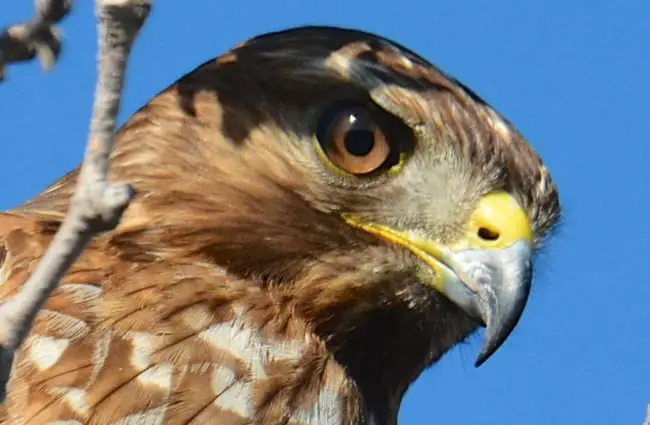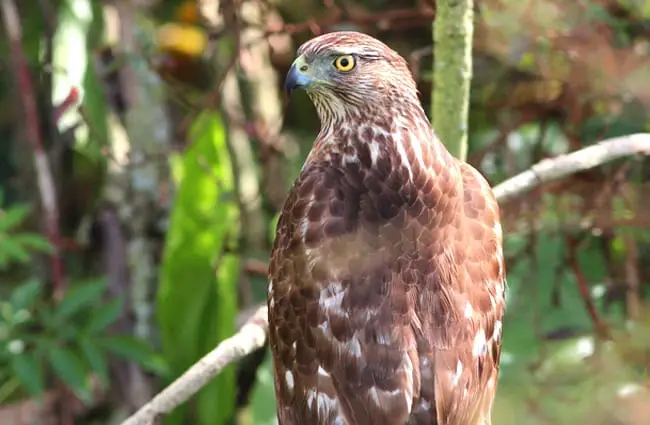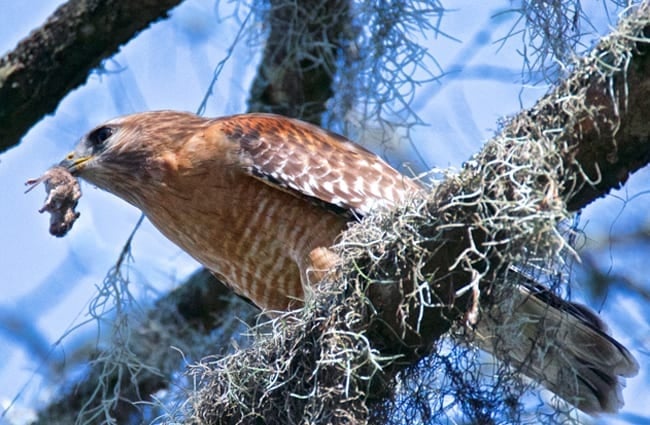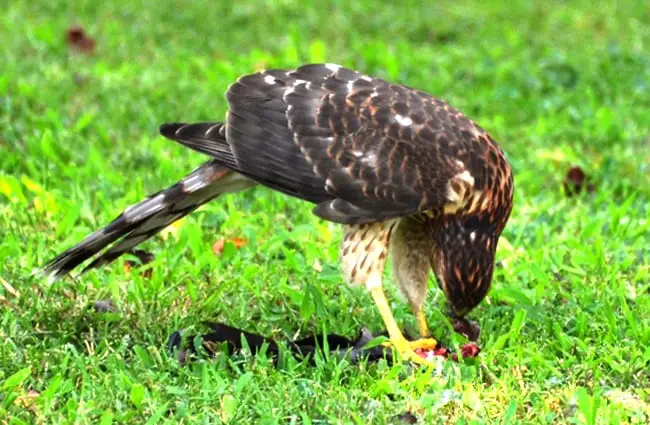Introducing the Cooper’s Hawk: A Master of the Skies
The Cooper’s Hawk, a medium‑sized raptor, is a fascinating and adaptable bird of prey found throughout North America. Known for its agility and hunting prowess, this hawk occupies a unique niche within various ecosystems. From suburban backyards to dense forests, the Cooper’s Hawk demonstrates a remarkable ability to thrive in a changing world. This article will delve into the life history, behavior, and ecological significance of this captivating predator.

Basic Information and Identification
The Cooper’s Hawk (Accipiter cooperii) typically measures between 14 and 17 inches in length, with a wingspan of roughly 29 to 35 inches. Adults exhibit striking plumage. Males are smaller and have slate‑blue backs, reddish barring on the chest, and a white rump. Females are larger and display similar coloration, though the barring is often more pronounced. Juvenile Cooper’s Hawks have brown and white streaking on their underparts, which gradually transitions to the adult plumage as they mature.
A key feature aiding identification is the hawk’s distinct flight pattern. It combines bursts of rapid wingbeats with gliding phases, enabling it to navigate through dense woodland with remarkable maneuverability. This is in contrast to the more soaring flight of broader‑winged hawks.
Habitat and Distribution
Cooper’s Hawks exhibit a broad distribution, ranging from southern Canada through the United States and into Mexico. Historically, these hawks were largely confined to mature forests with abundant prey. However, they have increasingly adapted to human‑altered landscapes. Today, they can be found in suburban areas, parks, and even urban environments, often near bird feeders that attract the small birds that make up their primary food source.

Preferred Habitats
- Deciduous and Mixed Forests: Providing cover for hunting and nesting.
- Riparian Areas: Offering corridors for travel and concentrated prey populations.
- Suburban and Urban Areas: Utilizing parks, gardens, and bird feeders.
Diet and Hunting Strategies
The Cooper’s Hawk is a formidable predator specializing in birds and small mammals. Their diet primarily consists of medium‑sized birds such as pigeons, starlings, jays, and doves. They also take rodents, rabbits, and occasionally reptiles or amphibians.
Their hunting strategy is particularly effective in forested environments. They are ambush predators, relying on stealth and surprise. Typically, they perch concealed within foliage, patiently scanning for unsuspecting prey. When a target is spotted, they launch a swift, direct attack, often pursuing their quarry through dense vegetation. Their long legs and sharp talons enable them to capture and dispatch prey efficiently.

Reproduction and Life Cycle
Cooper’s Hawks generally establish long‑term pair bonds, often remaining together for life. Breeding season typically begins in early spring. The pair constructs a bulky nest made of sticks and twigs, usually placed high in a deciduous tree. Nests are often concealed within dense foliage.
The female lays a clutch of two to five pale bluish‑white eggs. Incubation lasts approximately 30 to 36 days, with both parents sharing incubation duties. Upon hatching, the young hawks, known as eyasses, are altricial, meaning they are helpless and dependent on their parents for food and care. The parents provide a steady stream of prey, carefully tearing it into smaller pieces for the nestlings. Fledging occurs around 35 to 40 days after hatching. Young Cooper’s Hawks remain dependent on their parents for several more weeks, learning essential hunting skills before dispersing to establish their own territories.

Ecological Role and Interactions
As an important predator, the Cooper’s Hawk helps regulate prey populations. By controlling the numbers of birds and small mammals, they maintain the health and stability of ecosystems. They also influence prey behavior, causing animals to become more vigilant and selective in their foraging habits.
Cooper’s Hawks occasionally interact with other raptors such as Red‑tailed Hawks and American Kestrels. These interactions can range from competitive exclusion to resource sharing. They are also preyed upon by larger raptors, such as Great Horned Owls and Northern Goshawks.
Cooper’s Hawks and Humans
Historically, Cooper’s Hawks suffered from persecution due to misconceptions about their impact on game bird populations. They were also affected by pesticide use, particularly DDT, which caused eggshell thinning and reproductive failure.
Fortunately, populations have rebounded significantly since the banning of DDT and increased public awareness of the hawk’s ecological importance. However, conflicts can still arise, especially in suburban areas where hawks may prey on pet birds or chickens.

Living with Cooper’s Hawks
- Protect Pet Birds: Bring bird feeders indoors during peak hawk activity.
- Secure Poultry: Provide covered runs or coops for chickens and other fowl.
- Appreciate Their Role: Recognize the hawk’s importance as a natural predator.
Advanced Insights
Evolutionary History
The Cooper’s Hawk belongs to the family Accipitridae, which includes most of the world’s hawks, eagles, and kites. Its evolutionary origins can be traced back to the Miocene epoch, approximately 23 to 5 million years ago. Fossil evidence suggests that early accipitrids were terrestrial predators that gradually evolved the adaptations necessary for aerial hunting. The Cooper’s Hawk’s specialized morphology and hunting techniques reflect its adaptation to a niche that requires agility and precision in forested environments.
Conservation Status
Currently, the Cooper’s Hawk is listed as Least Concern by the International Union for Conservation of Nature (IUCN). Ongoing monitoring is essential to track population trends and identify potential threats. Habitat loss, fragmentation, and climate change could pose challenges to long‑term sustainability.

Behavioral Ecology
Cooper’s Hawks exhibit a complex array of behaviors, including territorial displays, courtship rituals, and solitary hunting behaviors. They are highly intelligent and adaptable, capable of learning from experience and adjusting their behavior to changing environmental conditions. Further research is needed to fully understand the intricacies of their social interactions and cognitive abilities.
Conclusion
The Cooper’s Hawk is a remarkable bird of prey, embodying the elegance and power of nature. Its adaptability, hunting prowess, and ecological significance make it a vital component of North American ecosystems. By understanding and appreciating this magnificent creature, we can contribute to its conservation and ensure its continued presence for generations to come.

![Red Angus Closeup of a beautiful Red Angus cowPhoto by: U.S. Department of Agriculture [pubic domain]https://creativecommons.org/licenses/by/2.0/](https://animals.net/wp-content/uploads/2020/03/Red-Angus-4-238x178.jpg)




![Red Angus Closeup of a beautiful Red Angus cowPhoto by: U.S. Department of Agriculture [pubic domain]https://creativecommons.org/licenses/by/2.0/](https://animals.net/wp-content/uploads/2020/03/Red-Angus-4-100x75.jpg)

